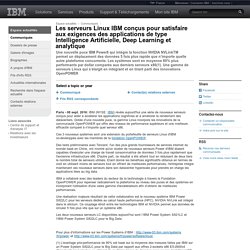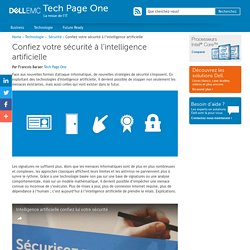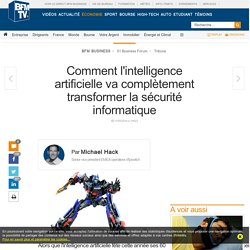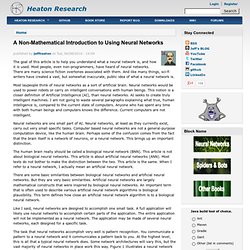

Veille technologique IA. L'Intelligence artificielle a des super-pouvoirs de cybersécurité... 60 ans après sa création. L’Intelligence Artificielle (IA) fascine et ses applications dans le monde réel, notamment en entreprise, sont bien loin de la science-fiction.

IBM Espace actualités - 2016-09-08 Les serveurs Linux IBM conçus pour satisfaire aux exigences des applications de type Intelligence Artificielle, Deep Learning et analytique - France. Paris - 08 sept. 2016: IBM (NYSE: IBM) révèle aujourd'hui une série de nouveaux serveurs conçus pour aider à accélérer les applications cognitives et à améliorer le rendement des datacenters.

IBM reconstitue un cerveau « numérique » de rongeur avec 48 puces neuromorphiques. L’été dernier, IBM levait le voile sur sa puce neuromorphique développée dans le cadre du programme de recherche SyNAPSE (pour Systems of Neuromorphic Adaptive Plastic Scalable Electronics) lancé en 2008 et financé par la Darpa.

Baptisée TrueNorth, cette puce bioinspirée vise à reproduire dans le silicium un réseau de neurones artificiels. Au total, Big Blue avait réussi à intégrer un million de neurones artificiels et 256 millions de synapses sur une puce de 4,3 cm. Les chercheurs avaient même réussi à interconnecter 16 puces TrueNorth. Selon un article du magazine Wired, daté du 17 août dernier, les équipes d’IBM sont parvenues à un nouveau record en assemblant 48 puces neuromorphiques, regroupant au total 48 millions de neurones artificiels, soit à peu près le nombre de neurones que l’on retrouve dans le cerveau d’un rongeur. Ces 48 puces neuromorphiques regroupent 48 millions de neurones artificiels, soit à peu près le nombre de neurones que compte un cerveau de rongeur. Intelligence Artificielle, une menace pour la sécurité informatique ? – Club Freelance – mission pour freelance informatique. La sécurité informatique est devenu l'enjeu principal d'un secteur en constante évolution.

Les autoroutes de l'information sont certes bien équipées en matériels et logiciels elles n'en restent pas moins extrêmement vulnérables aux malfaisants de tous horizons. Confiez votre sécurité à l'intelligence artificielle. Face aux nouvelles formes d'attaque informatique, de nouvelles stratégies de sécurité s'imposent.

En exploitant des technologies d'intelligence artificielle, il devient possible de stopper non seulement les menaces existantes, mais aussi celles qui vont exister dans le futur. Les signatures ne suffisent plus. Alors que les menaces informatiques sont de plus en plus nombreuses et complexes, les approches classiques affichent leurs limites et les antivirus ne parviennent plus à suivre le rythme. Grâce à une technologie basée non pas sur une base de signatures ou une analyse comportementale, mais sur un modèle mathématique, il devient possible d’empêcher une menace connue ou inconnue de s’exécuter. Comment l'intelligence artificielle va complètement transformer la sécurité informatique. En poursuivant votre navigation sur ce site, vous acceptez l'utilisation de cookies afin de réaliser des statistiques d'audiences et vous proposer une navigation optimale, la possibilité de partager des contenus sur des réseaux sociaux ainsi que des services et offres adaptés à vos centres d'intérêts.

Pour en savoir plus et paramétrer les cookies... Il semblerait que vous utilisiez un bloqueur de publicité. Deep learning, big data, réseaux de neurones... pourquoi l’intelligence artificielle revient-elle maintenant. S’il y a un réel renouveau des recherches sur l’intelligence artificielle (IA) et des peurs qu’elles suscitent, c’est que bien des choses ont changé, comme l’apparition de nouvelles technologies d’apprentissage automatique (machine learning), la démocratisation de moyens de calculs puissants, l’accès à des données massives (big data)...

Introduction aux techniques de base pour l'intelligence artificielle. Pour certains d'entre vous, la perspective de programmer un jour une IA pour des jeux de société/stratégie en tour par tour n'est pas totalement étrangère à votre apprentissage d'un langage de programmation.

Pourtant, d'autres priorités ayant pris le dessus, vous avez différé vos réalisations dans ce domaine. Sans toutefois vous en désintéresser définitivement. Plusieurs facteurs peuvent contribuer à expliquer la persistance de votre enthousiasme : Cet article s'appuie sur vos acquis en algorithmie pour aborder quelques techniques élémentaires de l'IA. J'ai volontairement limité le niveau algorithmique au strict minimum, non seulement afin de rester lisible par tous, mais aussi pour mieux introduire les modules d'ordre supérieur, une technique de modélisation très prometteuse pour l'intelligence artificielle.
Hilary Mason: An Introduction to Machine Learning with Web Data - O'Reilly Media. AlchemyAPI - Transforming Text Into Knowledge. MIT Computer Science and Artificial Intelligence Laboratory. Futurist: We'll someday accept computers as human. Futurist Ray Kurzweil spoke Monday at the South By Southwest Interactive conference.

Ray Kurzweil, the acclaimed inventor and futurist, believes that humans and technology are merging Kurzweil on portentous sci-fi fears about computers: "I don't see it as them vs. us"He spoke to a crowd of more than 3,000 at the South by Southwest Interactive conference. Neuro Evolving Robotic Operatives. Neuro-Evolving Robotic Operatives, or NERO for short, is a unique computer game that lets you play with adapting intelligent agents hands-on. Evolve your own robot army by tuning their artificial brains for challenging tasks, then pit them against your friends' teams in online competitions! New features in NERO 2.0 include an interactive game mode called territory capture, as well as a new user interface and more extensive training tools.
NERO is a result of an academic research project in artificial intelligence, based on the rtNEAT algorithm. It is also a platform for future research on intelligent agent technology. A Non-Mathematical Introduction to Using Neural Networks. The goal of this article is to help you understand what a neural network is, and how it is used.

Most people, even non-programmers, have heard of neural networks. There are many science fiction overtones associated with them. And like many things, sci-fi writers have created a vast, but somewhat inaccurate, public idea of what a neural network is. OVERVIEW OF NEURAL NETWORKS. This installment addresses the subject of computer-models of neural networks and the relevance of those models to the functioning brain. The computer field of Artificial Intelligence is a vast bottomless pit which would lead this series too far from biological reality -- and too far into speculation -- to be included.
Neural network theory will be the singular exception because the model is so persuasive and so important that it cannot be ignored. Neurobiology provides a great deal of information about the physiology of individual neurons as well as about the function of nuclei and other gross neuroanatomical structures. But understanding the behavior of networks of neurons is exceedingly challenging for neurophysiology, given current methods. Nonetheless, network behavior is important, especially in light of evidence for so-called "emergent properties", ie, properties of networks that are not obvious from an understanding of neuron physiology.
Artificial Intelligence: A Modern Approach. Intelligent Machines: The truth behind AI fiction. Image copyright Thinkstock Artificial intelligence (AI) is the science of making smart machines, and it has come a long way since the term was coined in the 1950s. Nowadays, robots work alongside humans in hotels and factories, while driverless cars are being test driven on the roads. What is artificial intelligence? Synthetic intelligence. A Robot With A Simple Form of Consciousness. Synopsis A year ago, researchers endowed the walking robot Hector with a simple form of consciousness. Scientists have developed a prototype for self-replicating robots. Robotics researchers have constructed small cubes that with no exterior moving parts are able to propel themselves forward, climb and jump on top of each other and snap together to form arbitrary shapes. The cubes could even move while suspended upside down from metallic surfaces.
The idea first came about in 2011 when a research student at MIT called John Romanishin proposed a new design for modular robots to his robotics professor, Daniela Rus. At first Rus was unsure of the design; however two years later Rus showed a fellow robotics researcher at Cornell University, a video of prototype robots, based on Romanishin’s design, in action. Deep Learning for AI. Deep neural network program recognizes sketches more accurately than a human. The Sketch-a-Net program successfully identified a seagull, pigeon, flying bird and standing bird better than humans. (credit: Credit: QMUL, Mathias Eitz, James Hays and Marc Alexa) The first computer program that can recognize hand-drawn sketches better than humans has been developed by researchers from Queen Mary University of London. Known as Sketch-a-Net, the program correctly identified the subject of sketches 74.9 per cent of the time compared to humans that only managed a success rate of 73.1 per cent.
As sketching becomes more relevant with the increase in the use of touchscreens, it could lead to new ways to interact with computers. Touchscreens could understand what you are drawing enabling you to retrieve a specific image by drawing it with your fingers, which is more natural than keyword searches for finding items such as furniture or fashion accessories. Artificial intelligence program that learns like a child. Artificial intelligence programs may already be capable of specialized tasks like flying planes, winning Jeopardy, and giving you a hard time in your favorite video games, but even the most advanced offerings are no smarter than a typical four-year-old child when it comes to broader insights and comprehension. It makes sense, then, that researchers at the University of Gothenburg have developed a program that imitates a child's cognitive development.
"We have developed a program that can learn, for example, basic arithmetic, logic, and grammar without any pre-existing knowledge," says Claes Strannegård. Starting from a set of simple and broad definitions meant to provide a cognitive model, this program gradually builds new knowledge based on previous knowledge. Google’s artificial intelligence mastermind responds to Elon Musk’s fears. We can get along fine, at least for a few decades, according to Demis Hassabis. (Andrea Comas/Reuters) How to Make a Mind. Can nonbiological brains have real minds of their own? In this article, drawn from his latest book, futurist/inventor Ray Kurzweil describes the future of intelligence—artificial and otherwise.
Zuckerberg and Musk invest in brain-building AI firm. Mark Zuckerberg, Elon Musk, and Ashton Kutcher want to build an artificial brain that thinks the way you think. MIT Spinoff Funded $143M to Create Sentient Computers.